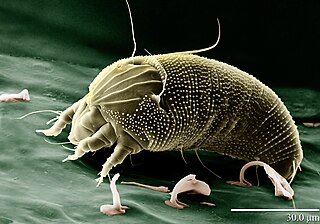 W
WAceria anthocoptes, also known as the russet mite, rust mite, thistle mite or the Canada thistle mite, is a species of mite that belongs to the family Eriophyidae. It was first described by Alfred Nalepa in 1892.
 W
WAculus laevis is a species of mite which causes galls on the leaves of sallows. It was first described by Alfred Nalepa in 1892.
 W
WAculus magnirostris is a species of mite which causes galls on the leaves of willows. It was first described by Alfred Nalepa in 1892.
 W
WAculus truncatus is a species of mite which causes galls on the leaves of purple willow. It was first described by Alfred Nalepa in 1892.
 W
WCassiopea xamachana, commonly known as the upside-down jellyfish, is a species of jellyfish in the family Cassiopeidae. It is found in warm parts of the western Atlantic Ocean, the Caribbean Sea, and the Gulf of Mexico. It was first described by the American marine biologist Henry Bryant Bigelow in 1892.
 W
WStratiolaelaps scimitus is a small (0.5 mm) light brown mite that lives in the top ½ in layer of soil. As a natural predator of fungus gnat pupae and of the snail parasite Riccardoella aspersa it is used by gardeners and snail breeders for biological pest control. Stratiolaelaps scimitus is also commonly used by reptile, amphibian and invertebrate keepers as a preventative or reactive measure against grain mites and reptile mites. Whereas most mite treatments are based on synthetic chemicals, predatory mites are used as a biological method of preventing and curing mite infestations.
 W
WMonachaster sanderi is a species of sea stars in the family Oreasteridae. It is the sole species in the genus Monachaster.
 W
WMuggiaea atlantica is a species of small hydrozoan, a siphonophore in the family Diphyidae. It is a cosmopolitan species occurring in inshore waters of many of the world's oceans, and it has colonised new areas such as the North Sea and the Adriatic Sea. It is subject to large population swings, and has been held responsible for the death of farmed salmon in Norway. The species was first described by J.T. Cunningham in 1892 from a specimen obtained at Plymouth, England.
 W
WPlacetron wosnessenskii, common name the scaled crab, is a species of king crab found in most waters off North America's west coast. It is the only species in the genus Placetron.
 W
WPsalidopus is a genus of shrimp placed in its own family, Psalidopodidae, and superfamily, Psalidopodoidea. It comprises three species, one in the western Atlantic Ocean, and two in the Indo-Pacific.
 W
WSalinella salve is a dubious species of very simple animal that may not exist, but which some have named as the sole member of the phylum Monoblastozoa. It was discovered in 1892 by Johannes Frenzel in the salt pans of Argentina and cultivated in a laboratory by him. This animal has not been found since and its real existence is considered as doubtful.